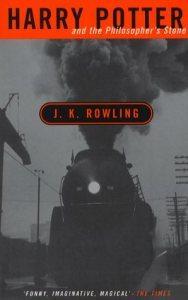
Cover art for Harry Potter and the Philosopher’s Stone, aimed at adult readers.
In the beginning they were furtive readers, hiding their primary coloured novels in their laps or slipping the dust jacket of the latest Andy McNab over their commuters paperback. Then, in 1998, Bloomsbury produced an adult edition of " target="_blank">Harry Potter and the Philosopher’s Stone. Those grown ups who had not yet succumbed to the thrall of the boy wizard now had permission to do so. It was a proper book now. A book for grown ups.
The only difference between the original, published a year before, and the new edition was the cover, a sophisticated monochrome photograph replacing the original colourful, bright and busy illustration. The move by Bloomsbury marked an important and interesting change in how we view children’s literature. Bluntly, if adults were not already reading Harry Potter, Bloomsbury wouldn’t be marketing the books to them.
Kids’ books were now officially part of pop culture – something that we ought to know about should we wish to converse with colleagues and friends. The move was repeated with subsequent novels in the series, and then, in 2005, both adult and child versions of " target="_blank"> … Half-Blood Prince were released simultaneously.
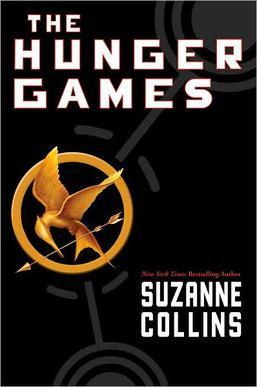
2008 Original Hunger Games cover art
When " target="_blank">… Deathly Hallows, the final novel in the Harry Potter series was released in 2007, a third of editions sold carried the adult cover*. In raw numbers that’s 1,268,738 copies; Harry Potter and the Deathly Hallows was number one on both the adult fiction and children’s fiction bestsellers list. More recently, Suzanne Collins Hunger Games trilogy has been aggressively marketed to the crossover audience, with a staggered release of differently targeted cover art (right).
It is not, however, just big franchise fiction that is treated this way. Mark Haddon’s The Curious Incident of the Dog in the Night-Time, published 2003, enjoyed the same fate, with simultaneous release of editions with covers for children and adults and became the best-selling British novel of the last decade, selling excess of two million copies.
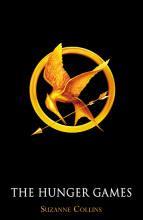
…and the 2011 ‘adult’ cover art
It is impossible to know how many adults read a kids’ version of a book and vice versa so it’s necessary to speak in general terms, using sales figures as a guide. Likewise, it would be disingenuous to suggest that crossover reading was a brand new phenomenon; the practice of separating books by readership is relatively new, influenced by socio-economic factors, industrialisation and the way that societies have viewed their children. But the fact remains. We do separate books by readership and we have done for long enough that crossing the self-imposed barrier that that creates is noteworthy.
This post is intended to address some of the first questions that spring to mind when crossover fiction is discussed: what is it, who does it, and why are they doing it. But before we get to any of that, it is necessary to first define the term.
Note: For the sake of brevity (and because I must subconsciously want to either alienate or patronise my readers) I’ll be referring to the practice of children reading nominally adult books as ‘reading up’ and the practice of adults reading nominally children’s books as ‘reading down’.
What is a crossover book?
Crossover books are generally thought of only in terms of reading down, that is adults reading books written for, or marketed to, children and teenagers. However, the phenomenon also exists in reverse – I’m thinking mainly of American classics like Catcher in the Rye, To Kill a Mockingbird and The Bell Jar though this suggests a more limited scope than is accurate - which I think it’s equally as important to address. In general terms, then, a crossover book is one written for children that is read by adults, or vice versa.
…But nothing’s ever that simple, is it? Books on the school curriculum are generally not considered crossovers because they are not read by choice or for pleasure, likewise books that parents and kids read together aren’t considered crossovers if the adult wouldn’t be reading the book if the child wasn’t there.
Of course, because we’re talking in broad trends there are plenty of exceptions to any rule of definition. There are too gray areas: does a childhood favourite re-read in adulthood count as a crossover? What about those books that began life in one classification and shifted to the other, like " target="_blank">Gulliver’s Travels? What about nonfiction; where does that fit in? These are questions that I’m not going to try to answer, at least here. It is outside the scope of this post and requires arbitrary judgements that are neither necessary nor, as far as this post is concerned, useful.
Reading up: big books in little hands.
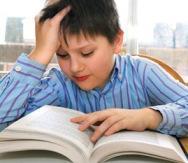
It’s probably Ulysses
I conducted an entirely unscientific poll among my friends asking what adult books they read when they were young. After a clarification of what I meant by ‘adult’ and a number of slightly red faces I found that genre fiction reigned supreme. Science fiction and swords-and-sourcery fantasy (in particular Isaac Asimov, Philip K. Dick and Ursula Le Guin), comedies by Ben Elton, Tony Parsons and Nick Hornby (with High Fidelity the most common), and the dreaded chick-lit all showed up in swathes. Classics like Pride and Prejudice and Emma, I Know why the Caged Bird Sings, The Color Purple and Margaret Atwood and Jeanette Winterson’s entire output were also frequently mentioned. Admittedly this data would be useless in any reasonably controlled study, but it definitely suggests that teenagers read widely, across classics, genre and literary fiction.
When I was a child, I spake as a child, I understood as a child, I thought as a child: but when I became a man, I put away childish things.
Corinthians 13:11 (King James version)
The tendency to read up begins in the teen years, precocity notwithstanding, at an age when young people are less willing to consider themselves children. Young people desire both to appear grown up t0 be recognised as such and the reading choices they make reflect this. The classics offer an edifying experience in relative safety: the literary lessons of human behaviour and emotion, the catharsis and the feeling of connectedness they provoke sit alongside the opportunity to learn the most impressive bon mots to parrot. We read these as teenagers for the same reasons we read them as adults: we want to be understood. Those great works of literature by great artists that we have found fit to canonise – Metamorphosis, Hard Times, Dracula, Of Human Bondage, Siddartha – all address the question that most concerns us in our teens: what is this world and who are we in it?
So, to a greater or lesser extent, does science fiction and fantasy. I, Robot and Do Androids Dream of Electric Sheep?, the most mentioned SF works among my responses, speak to a desire to understand humanity, and fantasy novels tend towards being explorations of society and how it works. Furthermore, genre fiction is (or at least has a reputation of being) more accessible than lit. fic. which would account for its high incidence on the list. Such works, like the comedies listed, offer temporary elusion from the problems of teen life, an accomplishment indeed when each problem is the absolute end of the world.
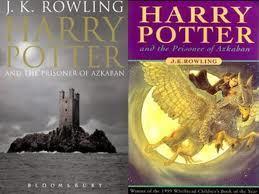
Harry Potter and the Prisoner of Askaban, in adult (l) and children’s (r) editions.
The argument that children and teens should not read up is predicated on the mistaken premise that books for children should be edifying and that books for adults, by their very nature, aren’t. Nothing could be further from the truth. The question of whether childrens’ books can only be justified their existence if they offer moral or practical instruction is one that I’ve answered elsewhere with a resounding ‘don’t be daft’.
Nevertheless, people are often concerned – because people are by and large idiots – that allowing children to read materials which are ‘unsuited’ to their age will be somehow damaging to their developing minds. Sex and violence are the main culprits, of course, but as a recent bit of Daily Mail hysteria** attests, anything that even vaguely falls into the category of ’real life’ is enough to engender a reactionary, pearl-clutching op-ed from someone with a deadline and nothing else to write about***. People are funny old things.
Society has a legitimate responsibility to protect the welfare of its young people, but sheltering our children from the harsh truths life is simply not in their best interests. Let me state this in no uncertain terms (as I have before). Childhood is not sacred. Innocence is not there to be protected. Bad things happen. One day your children will learn that people die or have sex or use drugs or get ill or use violence and offensive language. Let it be in the context of a story. Context is everything. For the final word on this, I’ll cede the floor to Sir Walter Scott, who was as right in 1827 as he is today:
There is no harm, but, on the contrary, there is benefit in presenting a child with ideas beyond his easy and immediate comprehension. The difficulties thus offered, if not to great or too frequent, stimulate curiosity and encourage exertion.
from the preface to Tales of a Grandfather
Reading down : it’s just genre.
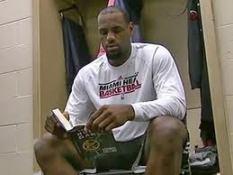
LeBron James reads The Hunger Games in the locker room.
A study of 2012 by Bowker Market Research (which, unfortunately, I am not able to access in its entirety, so it’s pinch of salt time) found that 55% of consumers of YA books are over 18, with 30-44 year olds accounting for 28% of YA sales. While grown ups continue to buy books on behalf of younger readers, fully 78% of respondents said they were buying YA fiction to read themselves. Why? Jack Zipes has a partial answer.
[Book purchases] are driven by commodity consumption that at the same time sets the parameters of reading and aesthetic taste. Today the experience of reading for the young is mediated through the mass media and marketing so that the pleasure and meaning of a book will often be prescribed or dictated by convention.
Sticks and Stones, p. 172
So, the conventional becomes phenomenal in part because mass media dictates it. Put differently, everyone read Harry Potter because everyone read Harry Potter and everybody read Twilight because everybody read Twilight. But market forces alone cannot be responsible for the surge in reading down, if only because not every book becomes as phenomenal as Harry Potter or Hunger Games. People looking for answers will often look to cultural, sociological and theoretical considerations and overlook the simple truth that adults read any kind of genre (as opposed to literary) fiction for the purpose of escapism.
“So, I’m taking you off post-modernists”.
“What are you prescribing?”
“There are these vampire books. The kids love ‘em. Trust me: they will empty your mind completely”.
Josh Radnor’s Liberal Arts, (2012)
We all read to empty our minds. We read to learn, sure; we read to feel; to experience vicariously; to engage in thought experiments and to challenge ourselves. But who among us can truly say they never read for pure escapism? To clear the horrors of modern life out of our systems and simply enjoy?
An article in the Independent in late 2011 argues that adults read down because books for younger readers offer them things that real life doesn’t. Fantasy and magic, considered perfectly acceptable as a part of literature for children, is marginalised as the reserve of ‘geeks’ and ‘nerds’ in adult culture. While geek culture has drifted towards the mainstream in recent years, this phenomenon pre-dates that. In a post-Potter literary landscape, does reading a fantasy or magic realism novel for children attract less stigma than reading, for example, George R. R. Martin’s Song of Ice and Fire saga or Robin Hobb’s Farseer trilogy? I don’t know for sure, but I’d be willing to bet that it’s less likely to attract negative associations from those who assume fantasy readers are all basement dwelling LARPers.
As well as offering generic acceptability, kidlit too offers a stylistic change from the mainstream of adult reading, especially, but not only, when it comes to the classics. Says Cambridge academic Dr. Louise Joy,
The pathos, the tragedy and the weight of the failure to communicate, notoriously exemplified in works such as Hardy’s Tess of the D’Urbervilles and Shakespeare’s Romeo and Juliet is a theme which often drives the adult novel. In a children’s book this possibility isn’t really entertained.
YA is not automatically dialogue heavy prose that’s all telling an no showing, but it’s certainly more likely to be. It is, after all, aimed at a less sophisticated audience that is still learning to parse writerly intent and the unwritten.
Those who contest that adults shouldn’t pick books from the kids section, like this NY Times columnist, do so out of pure snobbery. They do not denigrate kitlit and YA because it is lower in quality but because of an assumption that genre and popular fiction must automatically be unsophisticated. Is Daphne Du Maurier unsophisticated? Langston Hughes?
Genre fiction, like literary fiction, speaks to us, and that is why we read it. It might be more accessible than lit. fic.; it might be more focussed on plot or be driven mo re by market forces, but it is not to be sniffed at. Writer Elizabeth Lowell sums up the pull of pop. fiction on her website:
In our society, popular fiction is story after story told around urban campfires, stories which point out that life is not a tale told by an idiot, full of sound and fury and signifying nothing. There is more to life than defeat and despair. Life is full of possibilities. Victory is one of them. Joy is another.
Popular Fiction: Why we read it, why we write it
Closing thoughts
You’ll have noticed, if you’ve been paying attention, that my arguments for reading up and reading down mirror each other. Kids read up to push their boundaries, even though there are plenty of YA books that will allow them to do that, and adults read down to experience pure escapism, even though there are plenty of adult books that will allow them to do that.
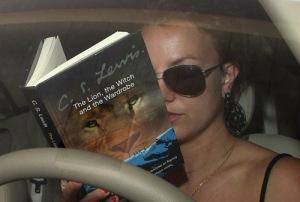
Britney Spears reads The Lion, the Witch and the Wardrobe
We can argue that reading down is indicative of a dumbing down of culture, or that reading up is indicative of the sexualisation and amorality of modern living. But that’s naive.At most, crossover reading is indicative of a widening of culture; a breaking down of self imposed, arbitrary limits that are useful to no one. People read because they like to read. What they read doesn’t matter.
—————————————————————————————————————————
*It’s interesting to note that the adult edition also sold, on average, for 61 pence more than the youth edition. We are willing to pay for our vanity, it seems.
**I considered using the phrase ‘bag of wank’ and decided against it due to wanting to be seen as vaguely authoritative, but fuck it: it’s my blog.
***The question of whether teenagers should be exposed to difficult or emotive subjects like terminal illness, drug taking and other bastions of the genre which I would call social realism but they have erroniously dubbed ‘sick-lit’^ is, again, not something I’m going to address here right now, but you can read a fair, if superficial, representation of my position on – of course – the Guardian website.
^The term ‘sick-lit’ refers specifically to a “genre of adolescent fiction that fuse[s] illness and romance narrative[s]“. The Daily Mail do not require the romantic element in their definiton, and include books that don’t have a traditional romance narrative such as Before I Die, The White Darkness and the nominally adult novel " target="_blank">The Lovely Bones (though The Lovely Bones could be considered kidlit by virtue of its adolescent narrator protagonist).
